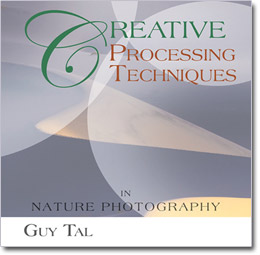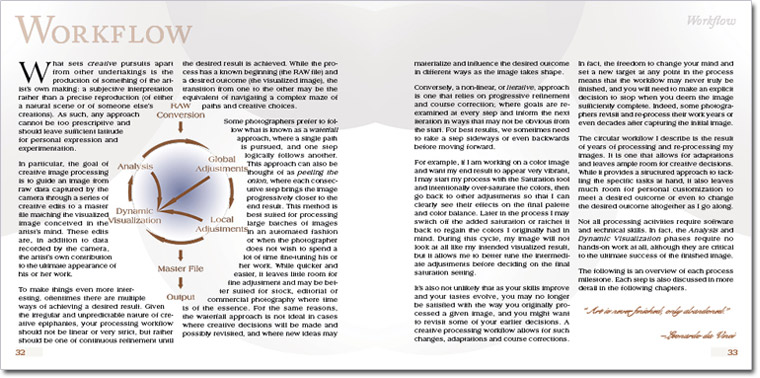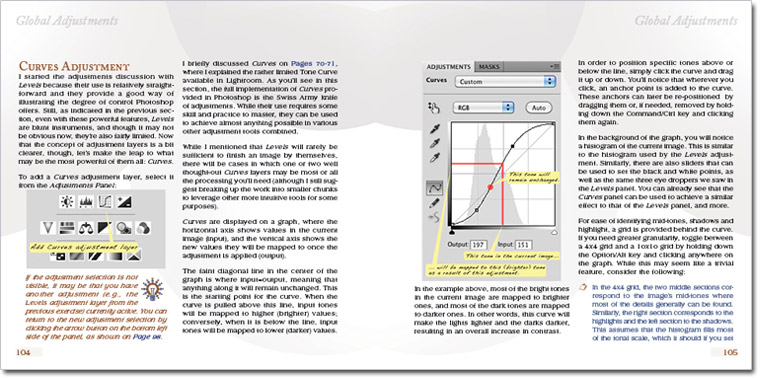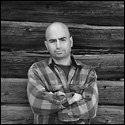
|
Among the topics covered are RAW conversion, adjustment tools such as Levels and Curves, using layers and layer masks, manual blending of multiple exposures, etc.
Excerpt - Creative Processing Techniques
To some, processing digital images is a daunting topic. Common misperceptions are that creative expression ends with the click of the shutter and time spent behind the computer screen is a necessary evil involving the tedious application of prescribed adjustments in robotic succession to achieve such trivial goals as more vibrant colors or gimmicky visual effects. Nothing could be further from the truth!

Certainly, digital image processing can be confined within limited boundaries, and much of it can be automated when the intent is simply to create usable images for a variety of purposes. In my classes, however, I refer to such simplistic processing goals as the “microwave approach” -- in goes a container of food, pre-mixed and flavored to meet a popular common denominator, and out comes an edible but generic meal. Although it may satisfy your hunger, the dining experience likely won’t be a memorable one.
By comparison, a creative cook revels in hand-selecting ingredients, adjusting amounts, optimizing cooking time and temperature, varying the recipe a little each time as skills and tastes evolve, experimenting, arranging the final presentation to add visual appeal, matching it with a suitable wine, and ultimately creating a holistic experience that is far more satisfying to both cook and guests.
Similarly, creative processing is about more than applying a generic recipe to the captured image or aiming for “acceptable” or “usable” results. The digital studio at your fingertips is every bit the fertile bed for creative expression as any field technique, and it allows complete control over how the raw data recorded by your camera will ultimately appear in the final image. Moreover, it provides the tools necessary to craft the image into a creation that is uniquely yours and representative of your own sensibilities, making you an active participant in shaping its appearance rather than a mere operator of camera controls.
In my Creative Landscape Photography book, I discuss the importance of Visualization: the ability to see in the proverbial “mind’s eye” the finished image early in the creative process and before making an actual exposure. Once conceived, the visualized image serves to guide subsequent technical and creative decisions, both in the field and in the studio. Each decision becomes another small step toward closing the gap between where the image is at a given point and the visualized end result.
In the processing phase, we have already found a worthy subject to photograph, determined the most favorable composition, and used our photographic equipment to record its visual qualities. At this point, we have all the raw ingredients necessary. Now is the time to take them into the kitchen and cook a visual feast. This is not the time to cut corners or to shove everything into the microwave, hoping the automated settings will transform the mix into a gourmet meal.
It should be acknowledged that some photographers’ primary motivation is the technical practice of their craft. They become enamored with the gear, the thrill of the hunt for interesting subjects, the desire to accurately render their subjects and quantifiable measurements of “image quality” rather than with subjective aspects such as emotional appeal or artistic expression. Creative photographers, on the other hand, while still relying on these same technical skills, are generally more concerned with personal expression and evoking a response from their viewers.
The goal of creative photography goes beyond the mere production of images that are technically good or that adequately reflect the subject as seen; rather, the goal is to produce images that uniquely represent the photographer’s vision and possess meanings beyond the literal visual elements they portray. This small shift in priorities can have profound implications when it comes to making processing decisions. Consider carefully where your own sensibilities fall between the two extremes before setting out to process your work.
The digital studio offers boundless opportunities for creative expression, experimentation and infusing your work with your own style and vision. Seen in this light, it is much more than just a set of tools for adjusting or correcting pixels. Rather, it is the place where your thoughts and ideas take shape and manifest themselves visually in your creations. Understanding the digital studio’s capabilities will also inform your decisions in the field and allow you to visualize more effectively as you factor in what you know to be possible.
It’s worth mentioning that your images will be processed whether you do it yourself or not. There is simply no way to make the transition from discrete light measurements taken by a digital sensor to a visible image without some degree of subjective decision-making. Your camera can process your images for you (e.g., if you work in JPEG mode) based on mathematical calculations programmed by software engineers with the aim of satisfying most people’s expectations, but obviously with no consideration of your creative ideas.
Working in RAW is also no guarantee of creative control. Your RAW conversion software can make decisions on your behalf if you choose to accept its default settings. And any number of other tools, scripts and actions can be used to add interesting effects at the click of a mouse -- effects representing the creative efforts of other people.

By delegating these tasks to the camera or automated software, you take yourself out of the driver’s seat and allow a computer to make creative decisions on your behalf. Computers may be accurate, and software may be designed to produce appealing results, but creative they are not. Even if they were, it would not be your creativity that comes into play. Creative processing is about taking control and putting in your own hands the power to guide an image toward your visualized end result.
In this book, I cover both technical and creative aspects of digital image processing, but it is not meant to be a comprehensive reference for every function of your imaging software. Rather than review every possible button, slider and dial, I work instead on understanding essential concepts of digital imaging and how they can be creatively applied to make the transition from raw data recorded by the camera to an expression of your own vision, making your work more than just a collection of images, but instead your art.
To get your own copy of the 168-page Creative Processing Techniques eBook, visit guytalbooks.com.
Comments on NPN nature photography articles? Send them to the editor. NPN members may also log in and leave their comments below.
 Guy Tal is a professional photographer and author residing in the state of Utah, in the heart of a unique and scenic desert region known as the Colorado Plateau. Guy teaches and writes about the artistic and creative aspects of photography and guides private workshops and individuals seeking the beauty and solitude of the canyon country. More of his works and writings can be found on his web site and blog at guytal.com. You may also follow Guy on Facebook or Twitter.
Guy Tal is a professional photographer and author residing in the state of Utah, in the heart of a unique and scenic desert region known as the Colorado Plateau. Guy teaches and writes about the artistic and creative aspects of photography and guides private workshops and individuals seeking the beauty and solitude of the canyon country. More of his works and writings can be found on his web site and blog at guytal.com. You may also follow Guy on Facebook or Twitter.